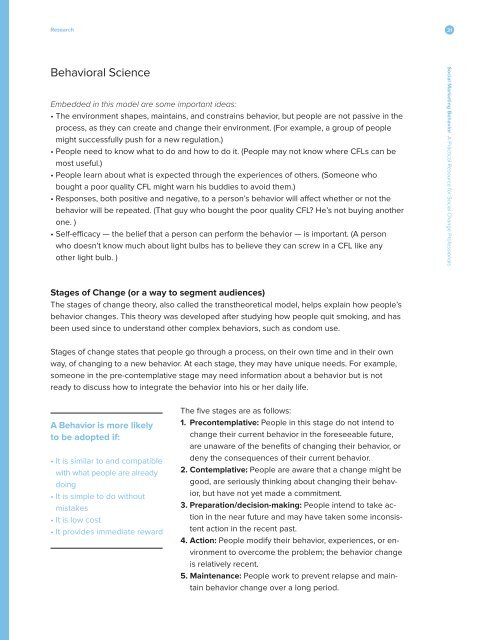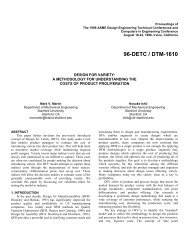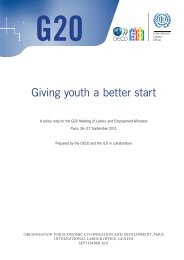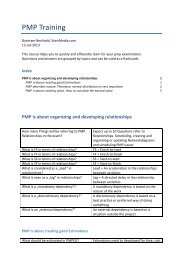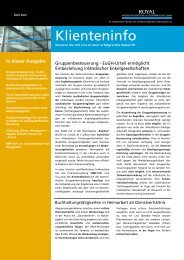Social Marketing
Create successful ePaper yourself
Turn your PDF publications into a flip-book with our unique Google optimized e-Paper software.
Research 31<br />
Behavioral Science<br />
Embedded in this model are some important ideas:<br />
• The environment shapes, maintains, and constrains behavior, but people are not passive in the<br />
process, as they can create and change their environment. (For example, a group of people<br />
might successfully push for a new regulation.)<br />
• People need to know what to do and how to do it. (People may not know where CFLs can be<br />
most useful.)<br />
• People learn about what is expected through the experiences of others. (Someone who<br />
bought a poor quality CFL might warn his buddies to avoid them.)<br />
• Responses, both positive and negative, to a person’s behavior will affect whether or not the<br />
behavior will be repeated. (That guy who bought the poor quality CFL? He’s not buying another<br />
one. )<br />
• Self-efficacy — the belief that a person can perform the behavior — is important. (A person<br />
who doesn’t know much about light bulbs has to believe they can screw in a CFL like any<br />
other light bulb. )<br />
Stages of Change (or a way to segment audiences)<br />
The stages of change theory, also called the transtheoretical model, helps explain how people’s<br />
behavior changes. This theory was developed after studying how people quit smoking, and has<br />
been used since to understand other complex behaviors, such as condom use.<br />
Stages of change states that people go through a process, on their own time and in their own<br />
way, of changing to a new behavior. At each stage, they may have unique needs. For example,<br />
someone in the pre-contemplative stage may need information about a behavior but is not<br />
ready to discuss how to integrate the behavior into his or her daily life.<br />
A Behavior is more likely<br />
to be adopted if:<br />
• It is similar to and compatible<br />
with what people are already<br />
doing<br />
• It is simple to do without<br />
mistakes<br />
• It is low cost<br />
• It provides immediate reward<br />
The five stages are as follows:<br />
1. Precontemplative: People in this stage do not intend to<br />
change their current behavior in the foreseeable future,<br />
are unaware of the benefits of changing their behavior, or<br />
deny the consequences of their current behavior.<br />
2. Contemplative: People are aware that a change might be<br />
good, are seriously thinking about changing their behavior,<br />
but have not yet made a commitment.<br />
3. Preparation/decision-making: People intend to take action<br />
in the near future and may have taken some inconsistent<br />
action in the recent past.<br />
4. Action: People modify their behavior, experiences, or environment<br />
to overcome the problem; the behavior change<br />
is relatively recent.<br />
5. Maintenance: People work to prevent relapse and maintain<br />
behavior change over a long period.<br />
<strong>Social</strong> <strong>Marketing</strong> Behavior A Practical Resource for <strong>Social</strong> Change Professionals


